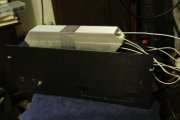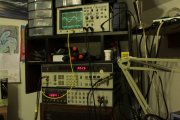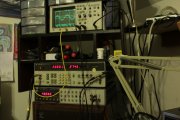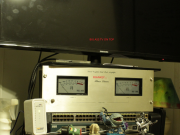- Joined
- Jun 11, 2010
- Messages
- 6,949
- Location
- Powhatan, Virginia, United States
- Tagline
- WassupYa Mang?
LOL so like in Sutt's 700 build thread I alluded to playing around with an IEE-488 GPIB controlled testing platform, based on the HP8903A analyzer. Was thinking if I needed to also include the HP3455A multimeter, but I'll cross that bridge when it comes.
So basically, so far what I've done is to create a little program that sends the appropriate commands, measures, etc. The first challenge was to figure out how to actively measure the voltage gain RATIO for the amp under test. Since this is a fixed and linear value, in theory I could use it to calculate the appropriate signal input voltage for whatever I needed on the output. And it works here.. (pressed the amp gain button, the results are shown in the readout on the bottom)

How do I know this is accurate? Well from there, I was able to calculate the appropriate input voltage for a "specific" power output by first calculating what actual output RMS volts was required for the specified wattage..
E (out) = SQRT(P x R) where E is the voltage needed, P is the power in watts desired, and R is the dummy load resistance (8 ohms in my case).
Once E (out) is known, E (input) is calculated by dividing the output voltage desired by the amp gain already precalculated in realtime and specific to the amp being tested.
And here's the result.. I wanted 55 watts.. the 8903A is capable of such a measurement..

Going to one watt, even closer.. close enough for my purpose!

And.. hell.. here you go. This is from my other WOPL which is a converted 400. Not too shabby considering ..
Watts..

Distortion at said watts..Mind you, this is one channel loaded due to the 700 whacking one of my dummy loads so it's conceivable ...

So the next challenge will be to write a routine that will (slowly but surely) increase the power output until the associated distortion measurement reaches.. say.. .5 percent. That should be a good indicator of the amp's single shot power capability.
More to come...this is FUN...
So basically, so far what I've done is to create a little program that sends the appropriate commands, measures, etc. The first challenge was to figure out how to actively measure the voltage gain RATIO for the amp under test. Since this is a fixed and linear value, in theory I could use it to calculate the appropriate signal input voltage for whatever I needed on the output. And it works here.. (pressed the amp gain button, the results are shown in the readout on the bottom)

How do I know this is accurate? Well from there, I was able to calculate the appropriate input voltage for a "specific" power output by first calculating what actual output RMS volts was required for the specified wattage..
E (out) = SQRT(P x R) where E is the voltage needed, P is the power in watts desired, and R is the dummy load resistance (8 ohms in my case).
Once E (out) is known, E (input) is calculated by dividing the output voltage desired by the amp gain already precalculated in realtime and specific to the amp being tested.
And here's the result.. I wanted 55 watts.. the 8903A is capable of such a measurement..

Going to one watt, even closer.. close enough for my purpose!

And.. hell.. here you go. This is from my other WOPL which is a converted 400. Not too shabby considering ..
Watts..

Distortion at said watts..Mind you, this is one channel loaded due to the 700 whacking one of my dummy loads so it's conceivable ...

So the next challenge will be to write a routine that will (slowly but surely) increase the power output until the associated distortion measurement reaches.. say.. .5 percent. That should be a good indicator of the amp's single shot power capability.
More to come...this is FUN...











